Construction Technology has undergone a remarkable technological transformation over the past four decades, ushering in a new era of innovation and efficiency. From the mechanization of labor-intensive tasks to the integration of advanced digital tools, the building sector has experienced a seismic shift, revolutionizing the way structures are designed, constructed, and managed.
At the heart of this transformation are key innovations that have reshaped the construction landscape. Mechanization, through the use of hydraulic and pneumatic devices, earth-moving equipment, and power tools, has significantly reduced the time and labor required for large-scale projects. Computer-Aided Design (CAD) has transformed the design process, allowing architects and engineers to visualize and detect conflicts in their plans with greater precision. Building Information Management (BIM) has enabled collaborative modeling and design among all project stakeholders, ensuring seamless integration and efficiency.
Prefabrication and industrialized construction have further streamlined the building process, with components fabricated off-site and then assembled on-site, increasing efficiency and reducing waste. Mobile devices have also played a crucial role, improving project management and enabling real-time analytics, while Robotic Total Stations have enhanced the precision and accuracy of layout tasks.
Sustainable building materials, such as cross-laminated timber and recycled materials, are not only reducing the industry’s carbon footprint but also offering cost-effective and energy-efficient solutions. Personal Protective Equipment (PPE) has safeguarded worker safety, while cloud computing has enabled real-time collaboration among project teams.
As the industry continues to evolve, emerging technologies like artificial intelligence (AI), machine learning, 3D printing, and extended reality are poised to shape the future of construction, further enhancing productivity, sustainability, and innovation.
Key Takeaways
- Mechanization, including hydraulic and pneumatic devices, has reduced labor and time in construction projects.
- Computer-Aided Design (CAD) and Building Information Management (BIM) have transformed the design and collaboration process.
- Prefabrication and industrialized construction have increased efficiency through off-site fabrication.
- Sustainable building materials, such as cross-laminated timber and recycled materials, are reducing the industry’s carbon footprint.
- Emerging technologies, including AI, machine learning, 3D printing, and extended reality, are poised to shape the future of construction.
The Evolution of Construction Technology
The evolution of construction technology dates back thousands of years, but the most significant advancements have occurred within the past 40 years. Mechanization has been a key driver, with the advent of hydraulic and pneumatic devices in the mid to late-19th century leading to the creation of earth-moving equipment and other apparatus that have significantly reduced the time and labor required for large-scale projects. In the early-20th century, mechanization advanced further with the introduction of cherry pickers, concrete mixers, cranes, power tools, and the internal combustion engine, which replaced manual labor with equipment like forklifts, tractors, and bulldozers.
Mechanization: Reducing Labor and Time
Prior to the 20th century, architects, draughtsmen, master stonemasons, and builders created magnificent buildings using methods of design and construction that were profound for their time. These methods remained largely unchanged until the latter part of the 20th century, when computer-aided design (CAD) emerged, transforming construction. CAD allowed designers to create 3D models and visualize design conflicts that were previously invisible in 2D plans and section drawings, revolutionizing the design process.
Computer-Aided Design (CAD): Visualizing Designs
While CAD greatly improved the design process, Building Information Management (BIM) has proven even more transformative, allowing all project stakeholders, including architects, engineers, contractors, and subcontractors, to collaborate on the fine details of design and construction by using the same database and computer model. BIM involves creating a detailed 3D model that includes all the functional systems of a structure, enabling all parties to visualize and analyze design decisions, and pinpoint interferences and other errors before work begins on site. This collaborative process saves resources by ensuring construction doesn’t start until every design has been submitted and conflicts have been resolved, leading to increased efficiency and productivity.
Building Information Management (BIM): Collaborative Modeling
The evolution of construction technology has been driven by a range of innovations, from mechanization and computer-aided design to the collaborative power of building information management. These advancements have transformed the industry, reducing labor and time, enhancing visualization, and enabling seamless collaboration among all project stakeholders. As the construction sector continues to embrace new technologies, we can expect to see even more groundbreaking changes in the years to come.
Prefabrication and Industrialization
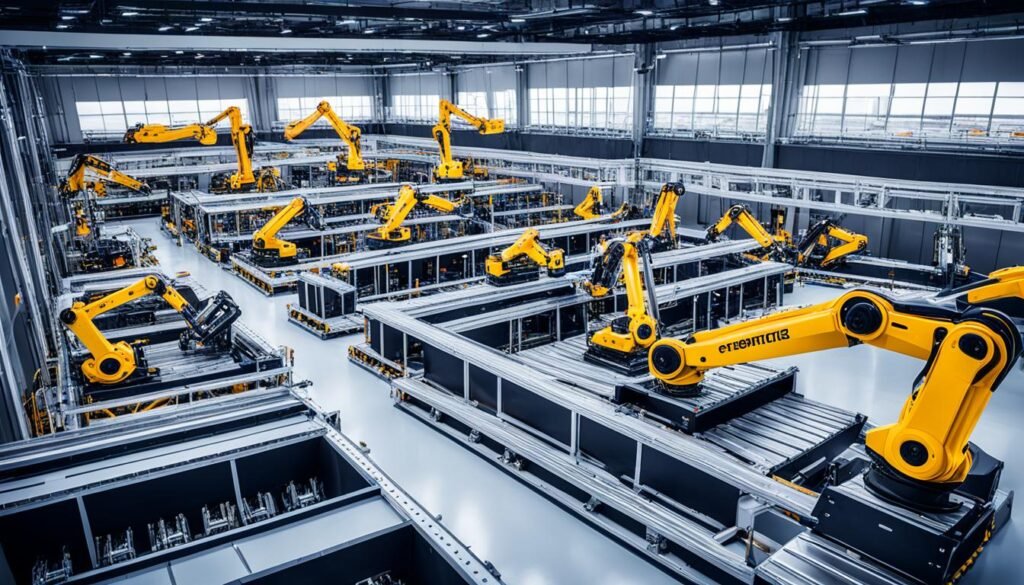
Assembling large, complex components piece by piece on-site, exposed to the elements, can be difficult. The rise of off-site fabrication has greatly increased the efficiency of this process. Components like heat exchangers, concrete insulated panels, timber frame panels, pump units, and instrument panels can be fabricated in a controlled shop environment, arriving on-site ready to be installed. This approach benefits from better management of parts and material inventories, as well as improved efficiency and productivity. According to a Dodge Data & Analytics report, 90% of contractors say they achieve improved productivity, quality, and schedule time certainty with prefabrication methods compared to traditional construction.
Modular Construction: Time and Cost Savings
Modular construction, a type of prefabrication, has also gained traction in the industry, offering significant time and cost savings. By fabricating large components or even entire building modules off-site, construction time can be greatly reduced, as the on-site work is limited to assembling the pre-built modules. This approach also reduces waste and improves quality control. According to the Dodge Data & Analytics report, 61% of construction firms expect to use prefabrication methods, including modular construction, in at least 10% of their projects in the next three years, up from 44% currently.
Mobile Devices and Real-Time Analytics

Mobile technology has transformed the construction project management landscape, allowing all parties involved to work together using the same consolidated information sources, ensuring no one is left out of the loop, no matter where they are. Smartphones and tablets have enabled real-time analytics in construction, empowering foremen to track performance, conditions, and costs during the day using mobile reporting tools, rather than having to create a report at the end of it.
Project managers can leverage mobile business intelligence to predict required corrections, enabling them to act straight away and keep things on schedule and within budget. This shift towards mobile technology and real-time analytics has significantly enhanced productivity and efficiency in the construction industry, giving teams the tools they need to make informed decisions and stay ahead of potential issues.
| Key Benefits of Mobile Devices and Real-Time Analytics | Metrics |
|---|---|
| Improved project management and collaboration | 92% of construction firms report increased productivity with mobile technology |
| Real-time data access and reporting | 85% of construction professionals use mobile devices on job sites daily |
| Predictive analytics and corrective actions | 78% of contractors say mobile tech has improved their ability to address issues quickly |
| Enhanced productivity and efficiency | 60% of construction firms expect to increase mobile tech investment in the next 3 years |
Robotic Total Stations (RTS): Precision Layout
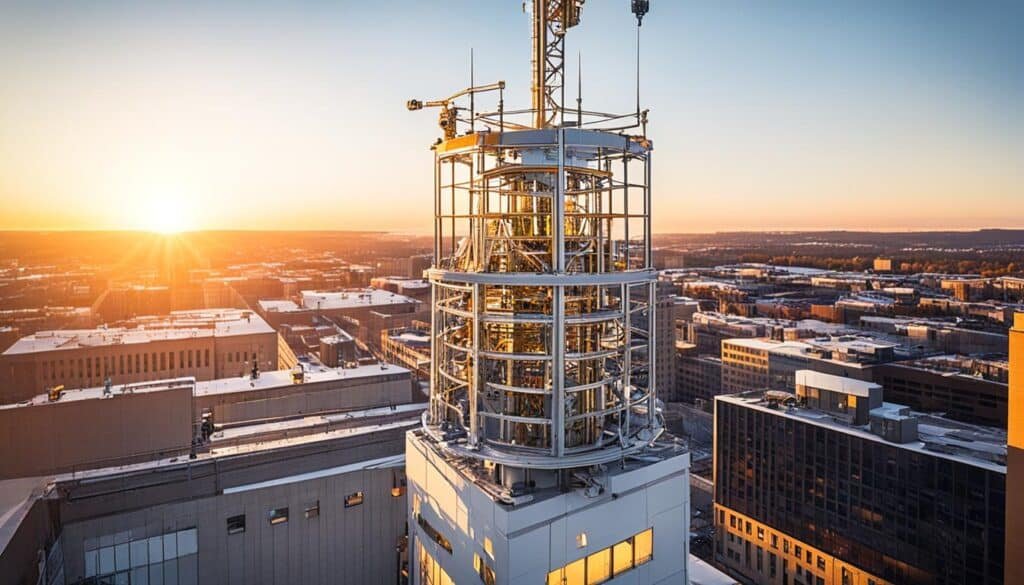
The traditional method of laying out building services on a site, using building drawings, tape measures, spirit levels, and theodolites, is time-consuming, arduous, and prone to errors, which can lead to serious consequences, such as clashes with other building services and prefabricated systems. Robotic Total Stations (RTS), which integrate an electronic theodolite with electronic distance measurement that can be remotely controlled, have revolutionized this process.
Using a tablet with the relevant software, a single person can complete the layout with greater efficiency, improved accuracy, fewer mistakes, reduced labor costs, and less paperwork. RTS offer a significant advantage over traditional theodolite-based methods, particularly in 3D modeling and precision layout applications, enabling construction professionals to achieve new levels of precision and cost savings.
Sustainable Building Materials

As the construction industry seeks to reduce carbon emissions, it is turning to more sustainable building materials, such as cross-laminated timber, reclaimed wood, bamboo, recycled rubber, and innovative materials like straw bales, rammed earth, Hempcrete, and Ferrock. Many of these materials are carbon-neutral, as they actually absorb and trap carbon dioxide. Using sustainable building materials not only benefits the environment, but it can also reduce construction costs, improve structural energy efficiency, and increase property value. Green buildings often have higher occupancy rates and rental rates than traditionally-constructed buildings, and they can also improve occupant health.
Cross-Laminated Timber and Recycled Materials
The construction industry’s shift towards sustainable building materials is driven by the need to reduce carbon emissions and environmental impact. Materials like cross-laminated timber, bamboo, and recycled rubber are not only eco-friendly, but they can also provide cost savings, improved energy efficiency, and increased property value.
Carbon-Neutral and Eco-Friendly Alternatives
Innovative materials, such as straw bales, rammed earth, Hempcrete, and Ferrock, are even carbon-neutral, actively absorbing and trapping carbon dioxide. The demand for sustainable, green buildings is high, as they often have higher occupancy rates, rental rates, and can even improve occupant health, making them a win-win-win for the industry, occupants, and the planet.
Personal Protective Equipment (PPE)
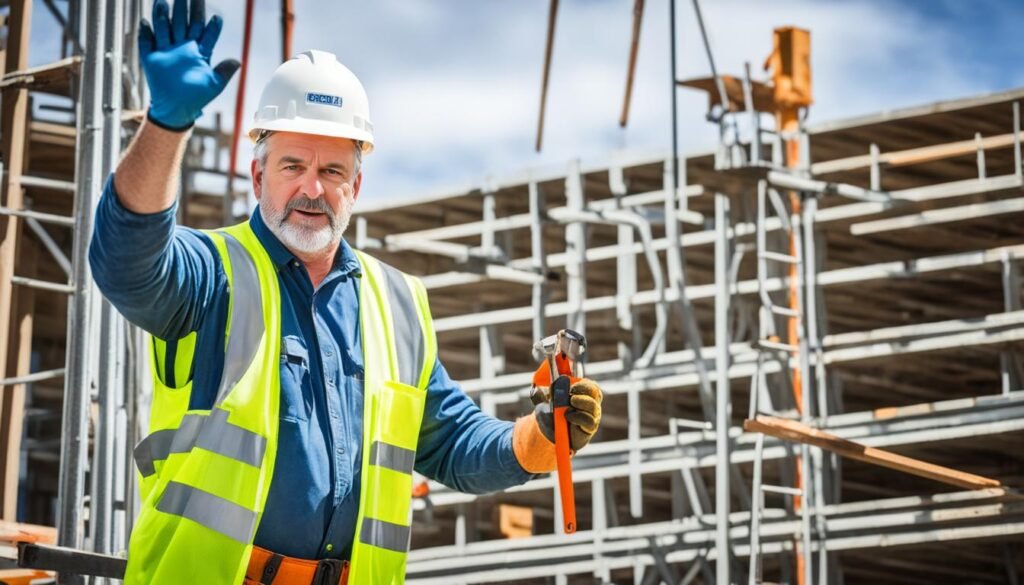
While personal protective equipment (PPE) may not be as technologically advanced as other construction innovations, it has nonetheless contributed significantly to revolutionizing the industry in terms of health and safety. Regulations, such as the Occupational Safety and Health Act of 1970 in the United States and similar legislation in other countries, have mandated the use of appropriate PPE for workers exposed to health and safety risks. These policies have been effective, with the number of fatal and non-fatal injuries to employees in the UK falling by 73% and 70% respectively between 1974 and 2007. However, construction workers still face a disproportionately high risk, accounting for 20% of worker deaths in the U.S. despite making up only 6% of the labor force, highlighting the ongoing need for PPE innovation.
Enhancing Worker Safety
While traditional PPE has made significant improvements to worker safety, there is still room for innovation in this area. One promising future development is the use of exoskeletons, which could enhance worker capabilities and further reduce the risk of injuries and fatalities on construction sites. Exoskeletons are wearable, motorized suits that augment the user’s strength and endurance, potentially allowing construction workers to lift heavier loads, work for longer periods, and avoid strain-related injuries. As the construction industry continues to prioritize worker safety, we can expect to see more advanced PPE solutions, like exoskeletons, emerge in the coming years.
Future PPE Innovations: Exoskeletons
One promising future development is the use of exoskeletons, which could enhance worker capabilities and further reduce the risk of injuries and fatalities on construction sites. Exoskeletons are wearable, motorized suits that augment the user’s strength and endurance, potentially allowing construction workers to lift heavier loads, work for longer periods, and avoid strain-related injuries. As the construction industry continues to prioritize worker safety, we can expect to see more advanced PPE solutions, like exoskeletons, emerge in the coming years.
Cloud Computing: Enabling Real-Time Collaboration
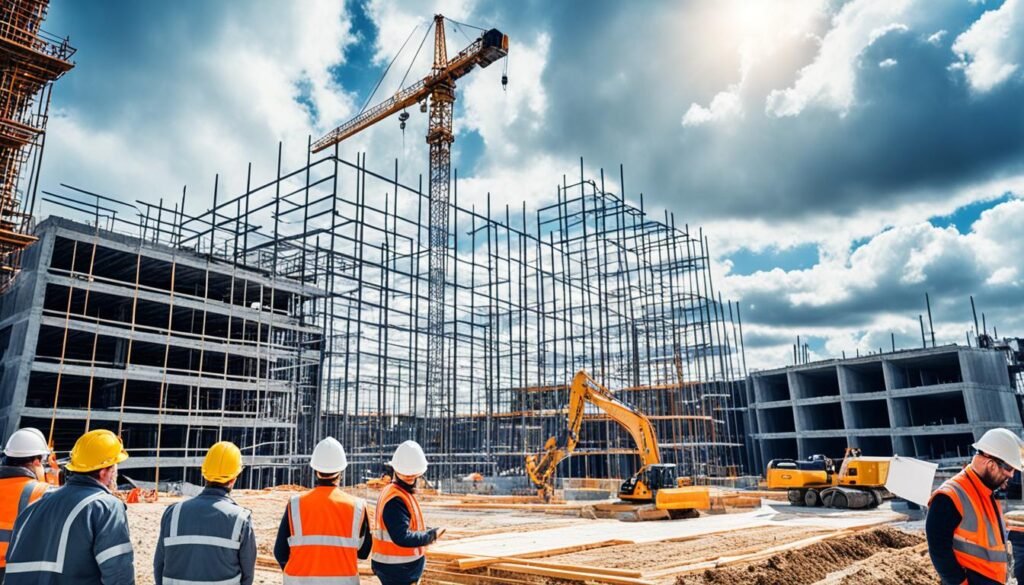
Cloud computing has been a fundamental driver of construction’s digital revolution. Before cloud computing, project data was restricted by hardware limits, but now, construction firms can outsource data processing and storage to powerful, accessible machines. This has resulted in nearly unlimited data storage and a truly connected jobsite, where real-time data is available to all stakeholders, facilitating easy sharing and collaboration. By harnessing the power of cloud computing, construction teams can work together more effectively, access the same information, and make better-informed decisions throughout the project lifecycle.
Construction Technology
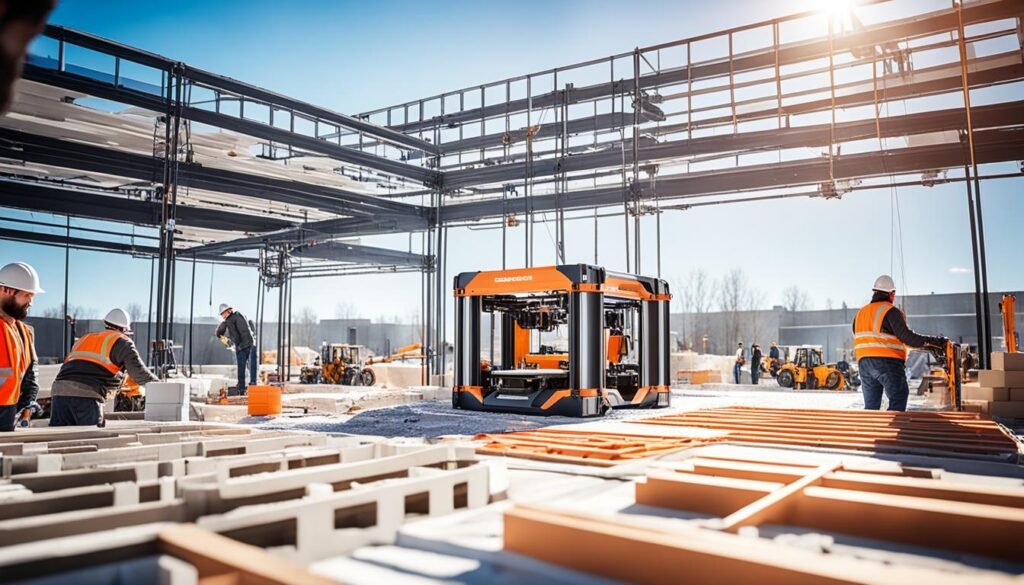
Innovations in artificial intelligence (AI) and machine learning are helping construction professionals optimize their workflows and aid decision-making. Predictive analytics, powered by machine learning and current/historical data, is quickly establishing its foothold in the construction industry’s technology stack. By leveraging predictive analytics, companies can make more informed decisions, mitigate risks, and prepare for challenges. Research shows that data-driven construction firms are seven times more likely to be using AI and machine learning. Tools like Construction IQ, powered by Autodesk AI, have helped companies like BAM Ireland improve on-site quality and safety by 20% and increase time spent on high-risk issues by 25%.
Artificial Intelligence and Machine Learning
Effective workforce and resource management are crucial for construction companies to keep operations running smoothly, optimize resource allocation, and avoid unexpected expenses and delays. Today, more construction firms are turning to software platforms to bring greater efficiency and actionable analytics to their workforce management. These solutions, such as Bridgit Bench and Riskcast, provide features like predictive tracking, forecasting, and mobile-first interfaces, removing many of the manual processes associated with resource planning. By accessing real-time metrics and forecasting analytics, companies can better allocate their workforce and equipment to the right projects at the right time, especially important in the current volatile market.
Workforce and Resource Management Software
3D printing has evolved from a novelty to an emerging industry standard in construction. With the right implementation strategy, 3D printing can help speed up projects, make materials more accessible, and enable the creation of intricate, customized designs. Construction firms are using 3D printing to create design elements like facades, as well as parts, fixtures, and furniture for their buildings. 3D printing is particularly useful when dealing with supply shortages or working in remote areas, as it allows for on-site manufacturing of needed materials. As 3D printing technologies continue to mature, we can expect to see more widespread adoption in the construction industry, helping companies improve quality control, address skilled labor shortages, and explore advanced design possibilities.
Emerging Technologies

Extended Reality (XR), AR, VR, and Metaverse
Extended Reality (XR), which encompasses Virtual Reality (VR), Augmented Reality (AR), and Mixed Reality (MR), is playing a pivotal role in revolutionizing Architectural, Engineering, and Construction (AEC) workflows. These immersive technologies, accessible through various devices, are enabling new ways of collaboration, issue tracking, error prevention, and enhanced spatial understanding. Tools like Autodesk Workshop XR are allowing AEC teams to scrutinize and problem-solve within their 3D models in a 1:1 scale, fostering a level of interaction that transcends traditional computer screens. The increasing adoption of XR signifies a paradigm shift in how construction professionals approach work, collaboration, and project success.
Sensor Data and Internet of Things (IoT)
Tracking the various components of a construction business, including manpower, jobsites, and equipment, is essential for effective project planning, smoother operations, and compliance with safety and worker regulations. Construction sensors and Internet of Things (IoT) technology are making this process easier than ever. Solutions in the market can enable monitoring of site conditions, material tracking through the supply chain, worker safety improvements, and better facility management. Forward-thinking firms are also using sensor data and software platforms like Forge to predict future product failures and optimize maintenance tasks, benefiting both their business and the environment.
Digital Twins: Virtual Replicas
Digital twins, which are digital replicas of physical entities, including buildings, are emerging as a significant technology in the construction industry. By creating a duplicate digital source of a physical structure, workers can assess, manipulate, and optimize the building. As they analyze the digital twin, they can uncover potential means of creating efficiencies, developing safety protocols, reducing risks, and improving quality. Digital twins enhance BIM by serving as a digital thread, connected directly to the physical structure. Since nearly 80% of a building’s lifetime value is realized during operations and maintenance, digital twins are proving invaluable in optimizing a structure’s performance and longevity.
Also Read: Sustainable Engineering Technology: Innovations for a Greener Future
Conclusion
The construction industry has undergone a remarkable transformation in the past 40 years, driven by a wave of technological innovations. From mechanization and computer-aided design to prefabrication, cloud computing, and emerging technologies like artificial intelligence, machine learning, and extended reality, the construction industry has embraced digital tools that are revolutionizing every aspect of the building process. These innovations have increased efficiency, productivity, and safety, while also enabling more sustainable and eco-friendly construction practices.
As the construction industry continues to evolve, we can expect to see even more groundbreaking technologies shape the future of construction, solidifying its position as a vital and innovative sector. From sensor data and the Internet of Things to digital twins and the metaverse, the construction industry is poised for a digital transformation that will redefine how projects are planned, executed, and maintained. By staying ahead of the curve and adopting these transformative technologies, construction firms can position themselves for success in an increasingly competitive and technology-driven landscape.
The future of the construction industry is undoubtedly bright, with innovation and digital transformation at the forefront. By embracing the latest construction technologies, the industry can continue to drive efficiency, productivity, and sustainability, ultimately delivering better outcomes for project stakeholders and the communities they serve.
FAQs
Q: What types of degrees or certificates are offered in the field of construction technology?
A: In the field of construction technology, you can pursue degrees such as associate in applied science or certificates in specific areas like carpentry or cabinet making.
Q: How can a construction technology program prepare me for a career in construction?
A: A construction technology program equips students with the necessary skills and knowledge in areas such as estimating, construction management, and hands-on trades to succeed in the construction industry.
Q: What career opportunities are available for graduates of construction technology programs?
A: Graduates of construction technology programs have a wide range of career opportunities in residential and commercial construction, including roles such as carpenters, plumbers, electricians, and construction managers.
Q: Is it possible to earn a degree or certificate in construction technology on a full-time basis?
A: Yes, many institutions offer construction technology programs on a full-time basis to allow students to focus on their coursework and complete their degree or certificate in a timely manner.
Q: How can I get started in a career in construction with no prior experience?
A: You can get started in a career in construction by enrolling in a construction technology program that provides hands-on training, real-world experience, and faculty advisors to help you navigate the field.
Q: What are the benefits of completing a construction technology program?
A: Completing a construction technology program can qualify you for entry-level positions in the construction industry, better understand the construction process, and open up opportunities for career advancement in the field.
Q: What specific skills can I expect to learn in a construction technology program?
A: In a construction technology program, you can expect to learn skills such as estimating, carpentry, cabinet making, plumbing, electrical work, and general construction trades to prepare you for a career in construction.
